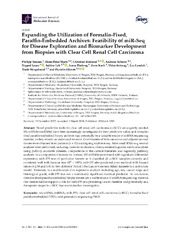Expanding the utilization of formalin-fixed, paraffin-embedded archives: Feasibility of miR-Seq for disease exploration and biomarker development from biopsies with clear cell renal cell Carcinoma
Strauss, Philipp; Marti, Hans-Peter; Beisland, Christian; Scherer, Andreas; Lysne, Vegard; Leh, Sabine Maria; Flatberg, Arnar; Koch, Even Evjen; Beisvag, Vidar; Landolt, Lea Zoe; Skogstrand, Trude; Eikrem, Øystein Solberg
Peer reviewed, Journal article
Published version

Åpne
Permanent lenke
https://hdl.handle.net/1956/19759Utgivelsesdato
2018-03-10Metadata
Vis full innførselSamlinger
Originalversjon
International Journal of Molecular Sciences. 2018;19(3):803 https://doi.org/10.3390/ijms19030803Sammendrag
Novel predictive tools for clear cell renal cell carcinoma (ccRCC) are urgently needed. MicroRNAs (miRNAs) have been increasingly investigated for their predictive value, and formalin-fixed paraffin-embedded biopsy archives may potentially be a valuable source of miRNA sequencing material, as they remain an underused resource. Core biopsies of both cancerous and adjacent normal tissues were obtained from patients (n = 12) undergoing nephrectomy. After small RNA-seq, several analyses were performed, including classifier evaluation, obesity-related inquiries, survival analysis using publicly available datasets, comparisons to the current literature and ingenuity pathway analyses. In a comparison of tumour vs. normal, 182 miRNAs were found with significant differential expression; miR-155 was of particular interest as it classified all ccRCC samples correctly and correlated well with tumour size (R2 = 0.83); miR-155 also predicted poor survival with hazard ratios of 2.58 and 1.81 in two different TCGA (The Cancer Genome Atlas) datasets in a univariate model. However, in a multivariate Cox regression analysis including age, sex, cancer stage and histological grade, miR-155 was not a statistically significant survival predictor. In conclusion, formalin-fixed paraffin-embedded biopsy tissues are a viable source of miRNA-sequencing material. Our results further support a role for miR-155 as a promising cancer classifier and potentially as a therapeutic target in ccRCC that merits further investigation.
